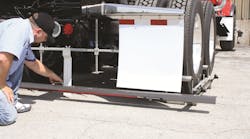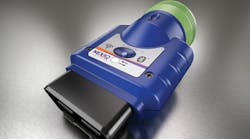With the rising costs fleets face today, it is important to take advantage of every savings opportunity. When it comes to the alignment on your vehicles, “close enough” can cost your fleet a lot of money. Alignment is extremely important from a tire-cost perspective.
If the truck isn’t properly aligned, fuel economy will suffer right along with tire life. In fact, the two are interrelated. Where do you think the energy needed to scrub that rubber off your tires comes from? Right out of the fuel tank.
Consider more frequent alignments
Performing more frequent alignments provides better control over a vehicle’s condition. A spokesperson for a major tire manufacturer reports that 1/8” excessive toe error produces 8’ of side slippage per mile, which can result in a reduction of tire life by as much as 25 percent.
It is known that proper alignment reduces certain types of tire wear and can improve fuel economy. The problem is, alignment is often not performed unless there’s an obvious need for it.
Cost is often cited as a barrier to more frequent alignments, as is the inconvenience of sending the truck out to have the work done. The alignment itself takes almost no time at all, but a truck and driver can be tied up for hours getting the vehicle to an alignment shop.
The number of vehicles in the fleet can help to determine if it makes sense to bring the work in-house where it can be performed more conveniently and more frequently, ultimately controlling costs and lowering total cost of ownership.
Another advantage to having your own alignment equipment is the pre-delivery inspection. Alignment should be checked when the truck is delivered, not at the first preventative maintenance (PM) interval. If it’s not right when it’s brand new, it’s not going to be right later on. It may be several months into the life of the vehicle when tire wear issues and driver handling complaints begin to manifest themselves. By then, it’s too late. The OE likely won’t honor the alignment warranty even though it may have not been correct in the first place.
With a dedicated alignment program, and one that is adhered to, it is possible to save tens of thousands of dollars per vehicle, per year. This does not include the other benefits of more frequent alignments, like improved handling and safety.
Importance of pre-alignment checks
When implementing an alignment program in-house, it’s important to complete pre-alignment checks for every vehicle. Consistently practicing thorough pre-alignment inspections can lead to an increased bottom line for your company. When you perform these checks, you significantly decrease your chances of overlooking a problem that could cause vehicle issues later, which could, in turn, cost your business money.
The first step in any pre-alignment inspection is to check and record the “cold” inflation pressure on each tire, typically after the vehicle has been at rest for several hours. Both steer tires should have roughly the same pressure, as should all drive tires and all trailer tires when compared to each other. Remember: No matter how precisely aligned the camber, caster, toe and tracking angles — the vehicle will still pull if there is uneven tire pressure.
Next steps involve checking the tires for irregular wear, including fast wear, feather wear, cupping, diagonal wear, rapid shoulder wear and one-sided wear. The type of tire wear patterns can indicate specific alignment problems. For example, a toe condition can quickly and easily be diagnosed if a technician notices steer tire feather wear to be in the same direction across the axle.
Also, make sure to check for problems like damaged springs, worn kingpins, loose bearings or worn steering linkage in the suspension.
While all inspections may not be necessary, properly executed checks ensure that each and every vehicle serviced in your bay is evaluated in the same way.
Conclusion
Whether you opt to bring alignment in-house, or continue to have vehicle alignment completed at another shop, a comprehensive pre-alignment check and more frequent alignments to vehicles on your fleet can aid in reducing operating costs.
Howard Williams is the Corporate Technical Sales Specialist at Bee Line Company. He has lead the computerized wheel alignment and truck frame correction factory and on-site training courses for Bee Line for more than 20 years. With his professional technical training and hands-on experience, Wiliams also oversees the corporate technical sales efforts for Bee Line.



